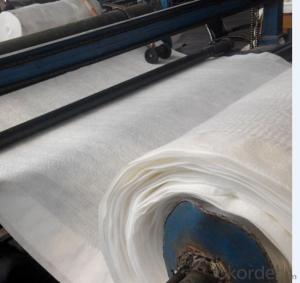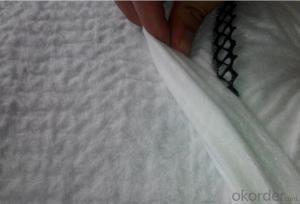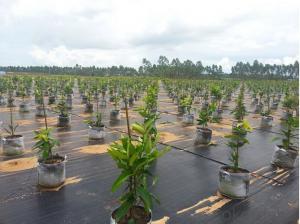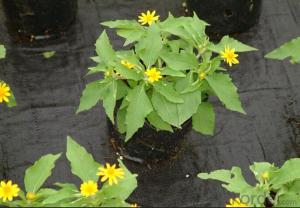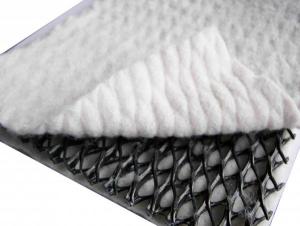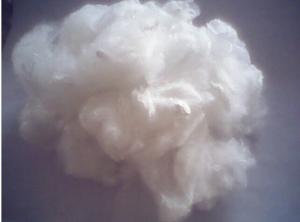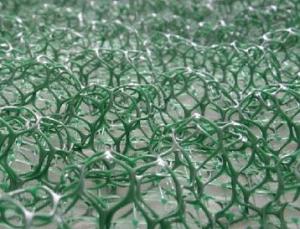Tri Geocomposite Drainage Net for Slope Protection
- Loading Port:
- Qingdao
- Payment Terms:
- TT OR LC
- Min Order Qty:
- 2000 m²
- Supply Capability:
- 200000 m²/month
OKorder Service Pledge
OKorder Financial Service
You Might Also Like
Tri Geocomposite Drainage Net for Slope Protection
Brief Description:
Geocomposite drainage is a drainage system consisting of three-dimensioanal high-density polyethylene
geonet, with high permeability, compressive strength and tensile strength, combined on one or both sides with
a nonwoven polypropylene geotextile.
Features:
Cost Effective - drainage nets can replace one or more feet of conventional aggregate drainage, increasing space within the landfill, allowing for additional revenue generation.
Versatility - drainage nets can be installed on steep slopes or against vertical walls where conventional drainage aggregates cannot be used.
Chemical Resistance - drainage nets exhibit the same chemical and biological resistance as the HDPE geomembrane.
Specifications and technical parameters:
Drainage network core | units | Specification | ||||
Unit weight | g/m2 | 750 | 1000 | 1300 | 1600 | |
Thickness | Mm | 5.0 | 6.0 | 7.0 | 7.6 | |
Hydraulic conductivity | m/s | kx10-4 | Kx10-4 | Kx10-4 | Kx10-4 | |
Elongation | % | 50 | 50 | 50 | 50 | |
Tensile strength (core netwaork) | kN/m | 8 | 10 | 12 | 14 | |
Geotextile | g/m2 | Heavier grades of geotextiles can be bonded to geonet on request | ||||
Usages:
In the railway, highway and other transportation infrastructure, drainage system safety and the service life
of the project and its have inseparable relationship, in which the geotextile material is an important part
of drainage system, the drainage effect of 3D composite drainage net is particularly notable. mainly
used for tunnels, municipal engineering, reservoir, revetment in drainage engineering.
FAQ
1.What is geosynthetics ?
Geosynthetics form a perfect erosion control fabric used extremely widely in civil engineering to stabilize and reinforce slopes and soil under or next to roads, railways, dams, water reservoirs etc.. They can be easily applied which minimizes the time of construction, as well as they limit the resources and materials necessary.
2.What kinds of geosynthetics we have ?
Non-woven geotextile, geogrids, geocells, GCL, Geomembranes, Geonets, Geocomposites etc .
3.What is the geosynthetics used for ?
Hydraulic
Lagooning and Water Treatment, Ornamental Ponds, Golf Courses
Aquaculture and Desalination,Water Lagoons,Tanks, Reservoirs, Liquid Waste,Floating Cover Solutions
Environment
Civil Works
Edification
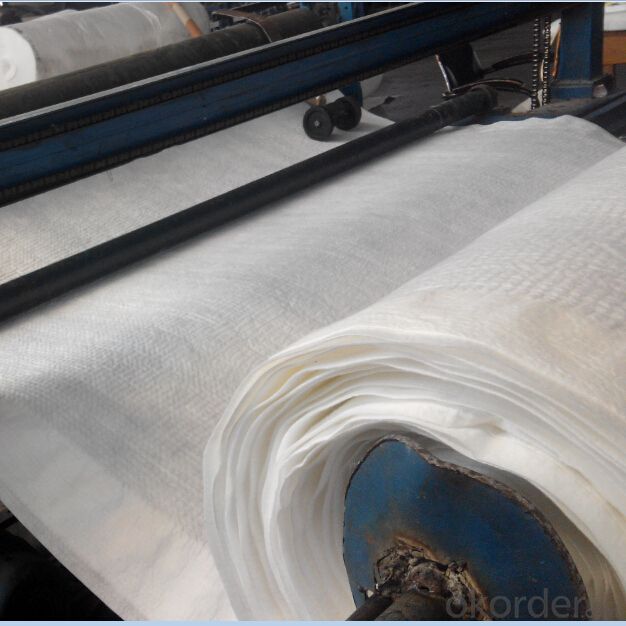
- Q:What are the specific applications of geocells in slope stabilization projects?
- Geocells are commonly used in slope stabilization projects to prevent soil erosion and landslides. They provide a stable and reinforced structure that enhances the load-bearing capacity of the slope. Geocells also promote vegetation growth, which further strengthens the slope and reduces erosion. Additionally, geocells are effective in constructing retaining walls, embankments, and terraces, making them versatile solutions for various slope stabilization applications.
- Q:What are the different types of geosynthetic tubes used in riverbank protection?
- There are several types of geosynthetic tubes used in riverbank protection, including geotextile tubes, geogrid tubes, and geocell tubes. Geotextile tubes are made of high-strength woven or non-woven geotextile fabric and are filled with sand or soil to provide erosion control and stabilize riverbanks. Geogrid tubes, on the other hand, are constructed using geogrid materials and are typically filled with aggregate or other materials to reinforce the riverbank. Geocell tubes consist of interconnected cells made of geosynthetic materials and are filled with soil or other materials to create a porous structure that prevents erosion and promotes vegetation growth. These different types of geosynthetic tubes offer various solutions for riverbank protection depending on the specific needs and conditions of the site.
- Q:For the civil engineering students, material mechanics need to grasp to what extent? Focus on Pretty good reference book
- Are you civil Material mechanics is the branch of the three major mechanics, of course, important, the design of the basis of the need to clearly grasp the material mechanics, such as the size of the beam design and check these in the engineering practice are directly used, many famous university entrance examination course is material Force rather than knot force can see its importance
- Q:What are the advantages of using geocells for load support applications?
- There are several advantages of using geocells for load support applications. Firstly, geocells provide excellent stability and reinforcement to the ground. The cells interlock with each other, creating a strong and stable structure that can distribute heavy loads effectively. This helps prevent soil erosion and settlement, ensuring the longevity of the load support system. Secondly, geocells are lightweight and easy to install. They can be quickly deployed and filled with locally available materials, reducing the need for heavy machinery and long construction times. This makes them a cost-effective solution for load support applications. Additionally, geocells have high load-bearing capacity. They can withstand heavy loads and distribute them evenly, reducing the stress on the underlying soil. This makes them suitable for a wide range of applications, including roads, railways, parking lots, and even retaining walls. Furthermore, geocells are environmentally friendly. By stabilizing the ground and preventing soil erosion, they help protect the natural environment. They also allow for the use of locally available materials, reducing the need for transportation and minimizing carbon emissions. Overall, the advantages of using geocells for load support applications include stability, ease of installation, high load-bearing capacity, and environmental friendliness.
- Q:Are earthwork products suitable for use in cemetery construction?
- Yes, earthwork products are suitable for use in cemetery construction. Earthwork products, such as soil, gravel, and stone, can be used to create pathways, build retaining walls, and fill gravesites. These materials are commonly used in cemetery construction to create a stable and aesthetically pleasing environment.
- Q:Are earthwork products suitable for slope stabilization?
- Yes, earthwork products are suitable for slope stabilization. These products, such as geotextiles, geogrids, and erosion control blankets, are specifically designed to reinforce and stabilize slopes by increasing the soil's strength and preventing erosion. They provide an effective solution to prevent slope failures and ensure long-term stability in various applications like highways, embankments, and retaining walls.
- Q:How are geotextile bags used in erosion control on riverbanks?
- Geotextile bags are commonly used in erosion control on riverbanks by acting as a protective barrier against soil erosion. These bags are typically filled with sand or soil and placed strategically along the riverbank to stabilize the soil and prevent it from being washed away by the force of the water. The geotextile fabric used in these bags allows water to pass through while retaining the soil, effectively reducing erosion and maintaining the stability of the riverbank.
- Q:Are earthwork products suitable for use in wetlands?
- Yes, earthwork products can be suitable for use in wetlands. However, it is important to consider the specific requirements and regulations governing wetland preservation and management. Proper planning, design, and implementation are crucial to ensure that the use of earthwork products in wetlands does not harm the natural ecosystem or disrupt the hydrology and wildlife habitat.
- Q:How are geosynthetic clay liners used in mining applications?
- Geosynthetic clay liners (GCLs) are used in mining applications as a barrier system to control and contain the movement of liquids and gases in waste containment areas. They are typically installed in the base and walls of mining pits or tailings storage facilities to provide an impermeable layer that prevents the seepage or leakage of harmful substances into the surrounding environment. GCLs offer high hydraulic conductivity and excellent chemical resistance, making them an effective solution for ensuring environmental protection and maintaining the integrity of mining operations.
- Q:Can earthwork products be used for beach erosion control?
- Yes, earthwork products can be used for beach erosion control. These products, such as sandbags and geotextile tubes, can be utilized to create barriers and reinforce beaches against erosion caused by waves and currents.
1. Manufacturer Overview |
|
|---|---|
| Location | |
| Year Established | |
| Annual Output Value | |
| Main Markets | |
| Company Certifications | |
2. Manufacturer Certificates |
|
|---|---|
| a) Certification Name | |
| Range | |
| Reference | |
| Validity Period | |
3. Manufacturer Capability |
|
|---|---|
| a)Trade Capacity | |
| Nearest Port | |
| Export Percentage | |
| No.of Employees in Trade Department | |
| Language Spoken: | |
| b)Factory Information | |
| Factory Size: | |
| No. of Production Lines | |
| Contract Manufacturing | |
| Product Price Range | |
Send your message to us
Tri Geocomposite Drainage Net for Slope Protection
- Loading Port:
- Qingdao
- Payment Terms:
- TT OR LC
- Min Order Qty:
- 2000 m²
- Supply Capability:
- 200000 m²/month
OKorder Service Pledge
OKorder Financial Service
Similar products
New products
Hot products
Related keywords
